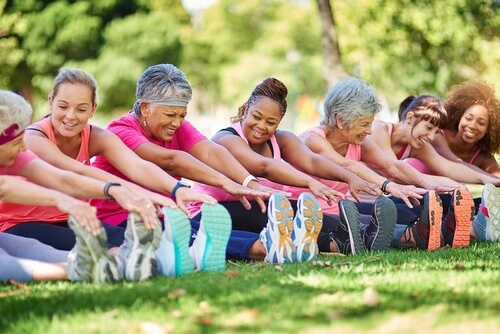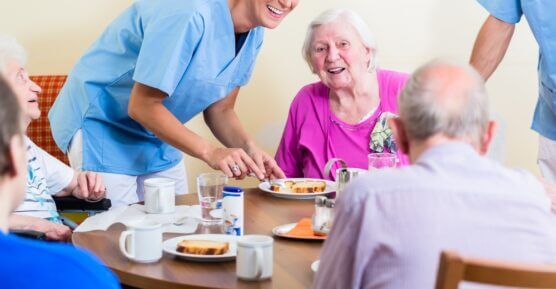
Being physically active is one of the best ways to improve physical and mental health in people of all ages.
However, research by Sport England found that 42% of people in the UK aged 55 and over are inactive.
It’s never too late to get more active (fitness influencer Joan Macdonald started at 70), but ageing can make movement more challenging. This can be due to:
- Stiffness – the joints rely on a lubricant called synovial fluid to reduce friction between bones. The production of this fluid can decrease with age and inactivity, resulting in stiff joints. Physical inactivity can also cause muscle stiffness
- Physical weakness – as people age, muscle mass naturally decreases if they are physically inactive. From their 30s this begins at the rate of 3-5% per decade, while this decline can be more rapid from 60s onwards
- Conditions more common in older people, such as arthritis and osteoporosis can make exercise painful
- Greater risk of injury
Unfortunately, it can be the case that the very things that make exercise difficult for an older person are worsened by inactivity, creating a cycle that is challenging to break from.
How much exercise should older people do?
The NHS states that people over the age of 65 should do a minimum of 150 minutes per week of moderate activity, or 75 minutes per week of vigorous activity.
While making the time for regular exercise sessions is a great thing to do, physical activity can be anything that gets you moving, including housework, getting off the bus a stop earlier, taking the stairs instead of the lift or taking up hobbies that require more physical energy.
Moderate activity examples include:
- Walking briskly
- Cycling
- Lifting weights and bodyweight strength training exercises such as squats, lunges and push-ups
- Swimming and water aerobics
- Dancing
- More physically demanding housework and gardening, such as scrubbing, washing laundry, vacuuming, digging, hoeing, raking and mowing the lawn
- Golf
- Doubles tennis
Vigorous activity examples include:
- Hiking or walking uphill
- Climbing stairs
- Cycling very fast or uphill
- Running
- Aerobics
- Team sports
- Singles tennis
Building up to this level of fitness can take time though, and people who have been sedentary for a long time or who are unable to do more physically demanding exercise can still reap benefits from gentle exercise.
Gentle and low impact activity examples include:
- Walking (not briskly)
- Less physically demanding housework and gardening, such as cooking, washing dishes and repotting plants
- Pilates or yoga
- Low-impact aerobics
- Lifting light weights
- Using a cross trainer/elliptical machine
What are the benefits of exercise for older people?
Keeping active increases independence in older people
Regular activity, including a mix of aerobic and strength-based exercises, can increase strength, mobility, flexibility and balance. It also gives you more energy.
These benefits help older people to maintain their independence, due to being better able to continue with day-to-day tasks and reducing the risk of falls and the serious injuries that they often result in. Sports like judo can even teach you how to fall in a way that minimises impact and injury.
Keeping fit also improves your reaction time, which can help people to keep driving for longer.
Strength and resistance exercise strengthens bones
Exercise, particularly resistance training, helps to maintain bone strength.
Hormonal changes that come with ageing mean that older people are more prone to bone fractures and breakages, particularly those who develop osteoporosis.
Regular strength training exercise, combined with a good diet, is a great preventative measure for reducing risks of falls and minimising injury when they do occur.
On the flip side, those with osteoporosis may be better off avoiding high-impact exercises such as running and high-intensity aerobics, as well as those that involve fast bends and twists. These can exacerbate pain and increase risk of injury, so some people find that slow, controlled movements like walking, lifting weights and/or using resistance bands slowly or swimming more advantageous.
Spending more time standing and moving about, rather than sitting, can also help to prevent back pain generally.
Exercise and the brain: Improved cognition and dementia prevention
As well as supporting a healthy body, exercise is good for the brain. Physical activity helps with memory, concentration and problem-solving, both immediately afterwards and in the long term when done regularly.
Exercise and activity increase blood flow to the brain, which carries oxygen and essential nutrient that support the brain to function at its best. It grows the hippocampus and pre-frontal cortex, areas of the brain responsible for memory, navigation, attention span and inhibitions.
Exercise is also found to increase the presence of brain-derived neurotrophic factor (BDNF), which supports the growth, health and function of neurons. BDNF can be lower in older people, particularly those living with dementia. Having plenty of BDNF helps your brain to function well and can even help to protect against dementia.
According to the Alzheimer’s Society:
- Regular exercise in mid-life reduces the risk of dementia by about 30% and Alzheimer’s disease by 45%.
- Aerobic exercise has been shown in one study to be more effective in preventing risk of dementia than not smoking, not drinking too much, having a healthy diet or being at a healthy weight.
How exercise improves mental health
Around one in four older people experience symptoms of depression, with bereavement, loneliness and physical ill-health being potential contributing factors.
While physical activity is not a cure in itself, it can certainly help.
Physical activity and exercise stimulate the production of endorphins and BDNF in the brain. It also reduces stress hormones such as cortisol. This can result in:
- A good mood immediately after exercising and a better mood in general when performed regularly
- Heightened self-esteem and self-worth
- Better sleep
- Reduced stress, anxiety and depression
30 – 60-minute sessions are said to be optimum for mental health benefits, while exercising for over three hours at a time can have negative effects.
Social connection for older people with group exercise
While some people prefer to exercise alone, many prefer classes, group activities and team sports.
For older people, who commonly experience loneliness and social isolation, the social opportunities afforded by group exercise can be particularly valuable, especially for those who have difficulty with one-to-one conversations due to dementia, hearing loss or other factors.
As well as classes held at gyms and community centres, there are group exercise options specifically for older people. Age UK runs such groups across the UK, with activities ranging from dance to walking football to Tai Chi. You can find out what they offer in your area using their postcode search.
Many towns and villages hold weekly walking groups, with options for level of ability. These and other accessible exercise groups are advertised in local newspapers, parish newsletters, town and village websites and on apps like MeetUp.
Exercise reduces risk of lifestyle and age-related illnesses
As well as helping to prevent dementia, anxiety and depression, keeping physically active is known to reduce the risk of a number of health conditions that are more common in older and inactive people, including:
- Type 2 diabetes
- Heart disease
- High blood pressure and high cholesterol
- Some types of cancer that are linked to obesity
- Osteoporosis
- Strokes
Find your ideal care home
- Explore a wide range of care options and facilities
- Read independent ratings and reviews
- Connect directly with care homes to book a tour and discuss your needs


